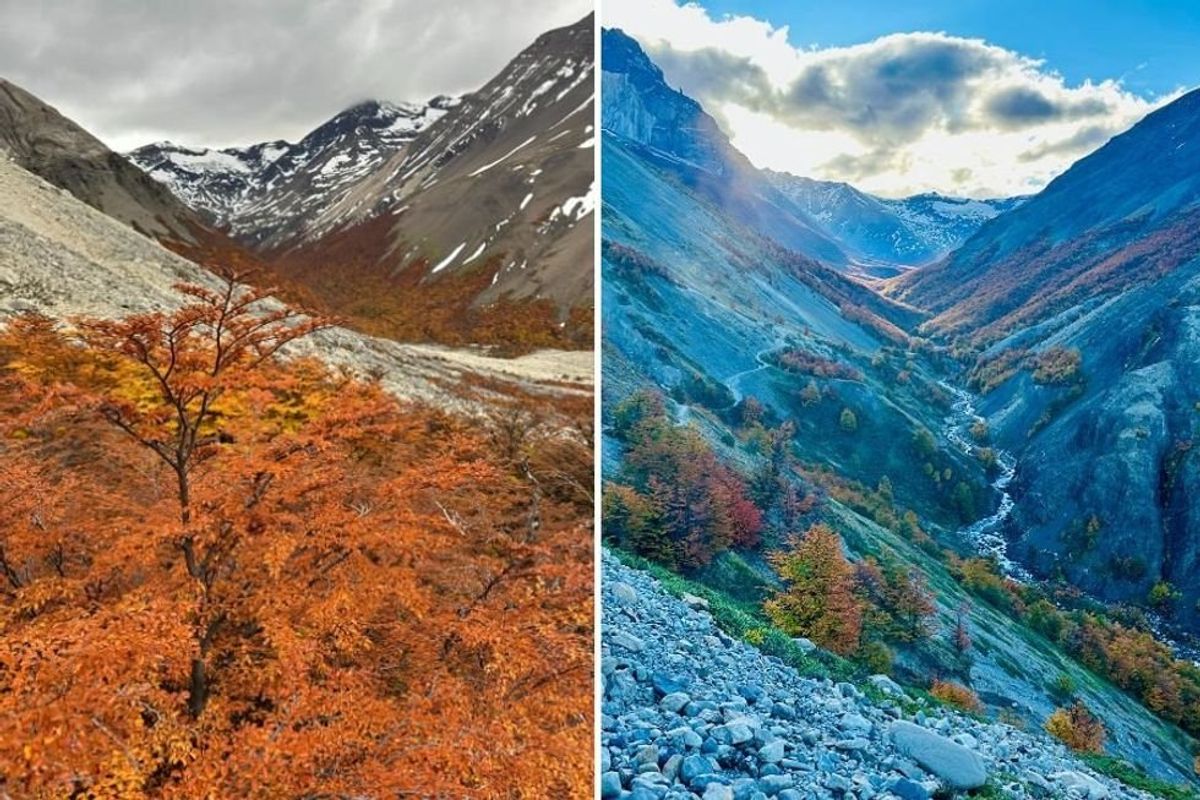
Shortly after leaving the Punta Arenas airport, our van driver points out the window and says in a distinct Chilean accent, “That’s where the Pacific meets the Atlantic.” Gazing out at the Strait of Magellan, which I’d only ever seen on a map, it hits home that we are farther south than 99.9% of the Earth’s population—quite literally at the end of the inhabited world. Five hours later, after passing herds of emus, flamingoes and guanacos (a relative of llamas), we reach Torres Del Paine National Park, the crown jewel of Chilean Patagonia.
I live in the Pacific Northwest and am no stranger to beautiful places, but Patagonia is on another level. One person here called it “savage beauty,” which is a perfect description—raw and rugged mountains, glaciers, lakes, forests, and prairieland on all sides at all times, with barely a sign of civilization. Torres Del Paine offers up close views of Grey Glacier, part of the Southern Patagonia Ice Field, the third largest freshwater reserve on Earth.

Grey Glacier, part of the Southern Patagonia Ice FieldsPhotos by Annie Reneau
If there’s any place that’ll make you fall head over heels for our gorgeous planet, it’s Patagonia.
I’ve come to Torres Del Paine National Park to witness this beauty and to see how Las Torres Patagonia’s “10 Volunteers for 10 Days” ecotourism contest played out. Las Torres is a privately owned reserve nestled inside the national park, and as part of their ongoing sustainability efforts, they are rebuilding a hiking trail that leads to the park’s iconic granite towers. Las Torres offered 10 voluntourists the opportunity to visit the reserve and help work on the trail. I accompanied the winners during the second week of April—peak autumn color time—to see firsthand why sustainable trail-building matters.

First, I got to experience the old trail, a 12.5 miles (20 km) round-trip hike to and from Base Torres, the base of the towers. It’s not easy, requiring a trek up and down 3,000 feet in elevation, but it is absolutely stunning. Imagine being surrounded by scenery like this with the occasional majestic Andean condor soaring overhead:

The hike takes you up mountainsides, through forests, across rivers, past waterfalls and finally up a steep boulder climb.

The trek ends at three huge granite towers flanked by a glacier with a bright turquoise lake greeting you like a scene from another planet. This is Base Torres.

The Base Torres trail is one of the most popular hikes in the park, and it sees a good percentage of the 250,000 visitors who visit Torres Del Paine each year. The problem is, it was never meant to be a hiking trail in the first place. Carved decades ago by cattle ranchers on horseback, the trail was created before the national park without any real thought to sustainability. Both human use and natural erosion have badly damaged the trail, making it incompatible with the protection and preservation of the natural landscape.
The goal is to make the trail both sustainable and accessible, minimizing human impact on the land while still allowing people to enjoy the park. I had no idea what went into creating a sustainable trail, but there’s a lot, from slope to drainage to impact on natural vegetation. Patagonia’s weather plays a big role in erosion as well, with strong winds and snowy winters that have to be taken into consideration. The new trail takes a different path than the old one, with a more gradual ascent and more up-close views of the Ascencio Valley and river, and offers a wider and more comfortable climb.

The trail rebuild is a huge, collaborative project between Las Torres, the park, international conservation and trail experts (such as Shuswap Trail Alliance and Conservation VIP) and others. For the past two years, both professional crews and volunteers have done the slow, manual labor required to build a trail in the wilderness, and there’s still a ways to go.
“It’s a colossal job. We need all the help we can get,” Las Torres CEO Josian Yaksik tells me. The Las Torres Reserve has belonged to Yaksik’s family for several generations, starting as a small, independent farm and growing into a multi-faceted business tied to the national park. Yaksik emphasizes that Las Torres takes responsible stewardship of the land seriously, protecting Patagonia while helping people enjoy it. That commitment becomes more and more apparent the more time I spend talking with the people who live and work on the reserve.
As I learn about the trail project and other sustainability efforts of Las Torres, I’m struck by how their conservation work is driven by two key elements of success: caring and collaboration. Conservation isn’t a political talking point here; it’s a way of life inspired by caring for such a beautiful place. And that genuine love for the land fuels a shared vision that invites collective action. Back home, we tend to place responsibility largely on the backs of individuals and their individual choices. Here, it’s clear that collaborative efforts aren’t seen as just nice to have, but rather must-haves in creating a unified system of sustainability.

The volunteers who worked on the trail noted that as well.
“It was eye opening to see how Las Torres along with the other organizations involved took something that is a big task and most hikers don’t blink an eye at, and said this is unacceptable and that they are going to change it,” shares Amanda Bjorge, a contest winner from Minnesota. “Seeing the trail that Las Torres and AMA [a non-profit NGO helping with the trail rebuild] are working on, the difference is astonishing. While the old trail is clearly a horse path, the new trail is made with so much careful thought and calculation into not just who will be traveling on it, but the effect that the elements may have on it.”
Patricia McGuire says her experience working on the trail showed her how passionate the Las Torres staff are about conservation. “This is the kind of work that requires sharing knowledge and building community,” she says. “It’s necessary to spread awareness of why sustainable trails are important in order for the work to continue happening.”
“The people of Las Torres know so much about the land and its history, and they’re passionate about it too, which really invites you to immerse yourself in the knowledge,” shares Angela Hrari from New York. “A majority of the food eaten at the hotel is grown on the premise to cut down on all the excess waste needed to transport food to remote areas. Every person I met had such deep reverence for the land, ensuring that we were leaving no trace and respecting the wildlife.” She adds that the new trail “ensures not only that differently abled bodies are going to have an easier time accessing hikes, but also many people for many generations to come can enjoy this land without the fear of turning it into an at-risk destination.”
Jon Moser, from Boulder, Colorado, says it was “amazing” to see the commitment to sustainability in Las Torres’s partnerships with conversation groups. “The entire hotel is a sustainability machine, harvesting from their gardens to create their menus, eliminating their use of plastic, and even using glacial runoff to distill their own gin,” Moser says. “Because I build trails for a living, this opportunity was obviously an immediate attraction, but getting the chance to be a part of trail construction that has been happening for the past two years was truly special.”
Some might wonder: Couldn’t people just not go to Patagonia at all and save the tourism impact rather than just trying to mitigate it? Sure. But it’s in our nature to explore nature, and we’re never going to be able to stop people from traveling to see naturally beautiful places. Sustainability is about balance, which includes balancing human activity with the needs of nature. When done responsibly, visiting and enjoying Earth’s wonders can not only nurture a love for our planet, which inspires greater conservation efforts to protect it, but also help us collaborate and learn from one another to improve those efforts as well.
The author was invited to Torres Del Paine as a guest of Las Torres Reserve. Las Torres did not review this article prior to publication.





















